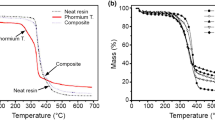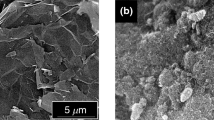Abstract
The synergistic effect of organically modified sepiolite nanoclay (SP) in conjunction with aluminum polyphosphate/pentaerythritol as an intumescent flame retardant (IFR) additive on the polyolefin elastomer/linear low-density polyethylene compound has been systemically investigated. The mechanical, thermal, flame-retardant, and morphological properties of the obtained compounds were analyzed by tensile test, thermogravimetric analysis, fire testing technology limiting oxygen index analyzer, cone calorimeter, and scanning electron microscopy and compared with the reference compound containing 60% (by wt) of aluminum trihydroxide (ATH) as a flame-retardant additive. The reduction of IFR content from 40 to 25% not only improved the tensile strength and elongation-at-break values it furthermore provided the mandatory flammability requirements of the ST8 type cable standard. The addition of 3 and 5% (by wt) of organomodified SP nanoclay as an anti-dripping agent into the compounds slightly improved the LOI values between 27 and 30%. Thermal properties of the compounds in the absence/presence of SP nanoclay were slightly improved by increasing IFR concentration. According to cone calorimeter results, the flammability parameters of the compounds such as heat release rate and total heat release values were significantly improved by incorporation of both IFR and SP nanoclay. Also, the addition of SP nanoclay as an anti-dripping agent reduced the burning rate and limited the heat and mass transfer on the surfaces. It was confirmed by SEM analysis that these surfaces were smoother and more compact carbonaceous residue with fewer cracks and holes.
Graphical abstract






Similar content being viewed by others
References
Mohite AS, Rajpurkar YD, More AP (2022) Bridging the gap between rubbers and plastics: a review on thermoplastic polyolefin elastomers. Polym Bull 79:1309–1343
Khosravi A, Fereidoon A, Khorasani MM, Saeb MR (2022) Experimental and theoretical mechanical behavior of compatibilized polylactic acid/polyolefin elastomer blends for potential packaging applications. Iran Polym J 31:651–663
Chum PS, Swogger KW (2008) Olefin polymer technologies—history and recent progress at The Dow Chemical Company. Prog Polym Sci 33:797–819
Weil ED, Zhu W, Patel N, Mukhopadhyay SM (1996) A systems approach to flame retardancy and comments on modes of action. Polym Degrad Stab 54:125–136
Morgan AB, Gilman JW (2013) An overview of flame retardancy of polymeric materials: application, technology, and future directions. Fire Mater 37:259–279
Heinz M, Callsen C, Stöcklein W, Altstädt V, Ruckdäschel H (2022) Halogen-free flame-retardant cable compounds: influence of magnesium-di-hydroxide filler and coupling agent on EVA/LLDPE blend system morphology. Polym Eng Sci 62:461–471
Li S, Li B (2011) Effect of elastomer on flame retardancy, thermal degradation, and mechanical properties of intumescent flame-retardant polyethylene. J Elastom Plast 43:257–273
Li Y, Qi L, Liu Y, Qiao J, Wang M, Liu X, Li S (2022) Recent advances in halogen-free flame retardants for polyolefin cable sheath materials. Polymers 14:2876
Vangrevelynghe M, Le Nouvel L, Pesenti C, Sonnier R, Ferry L, Gesta E, Lagrève C (2022) A method to quantitatively assess the modes-of-action of flame-retardants. Polym Degrad Stab 195:109767
Hollingbery LA, Hull TR (2010) The fire retardant behaviour of huntite and hydromagnesite—a review. Polym Degrad Stab 95:2213–2225
Meucci M, Haveriku S, Badalassi M, Cardelli C, Ruggeri G, Pucci A (2022) Effect of polyolefin elastomers’ characteristics and natural magnesium hydroxide content on the properties of halogen-free flame-retardant polyolefin composites. Micro 2:164–182
Jj Mu, Zhou R, Liu C, Su T (2021) Synergistic effect of intumescent flame retardant and zinc borate on linear low-density polyethylene. Polym Eng Sci 61:2820–2830
Doğan M, Yılmaz A, Bayramlı E (2010) Synergistic effect of boron containing substances on flame retardancy and thermal stability of intumescent polypropylene composites. Polym Degrad Stab 95:2584–2588
Liu Y, Zhao J, Deng C-L, Chen L, Wang D-Y, Wang Y-Z (2011) Flame-retardant effect of sepiolite on an intumescent flame-retardant polypropylene system. Ind Eng Chem Res 50:2047–2054
Pappalardo S, Russo P, Acierno D, Rabe S, Schartel B (2016) The synergistic effect of organically modified sepiolite in intumescent flame retardant polypropylene. Eur Polym J 76:196–207
Li S, Yuan H, Yu T, Yuan W, Ren J (2009) Flame-retardancy and anti-dripping effects of intumescent flame retardant incorporating montmorillonite on poly(lactic acid). Polym Adv Technol 20:1114–1120
Dittrich B, Wartig K-A, Hofmann D, Mülhaupt R, Schartel B (2013) Flame retardancy through carbon nanomaterials: carbon black, multiwall nanotubes, expanded graphite, multi-layer graphene and graphene in polypropylene. Polym Degrad Stab 98:1495–1505
Paszkiewicz S, Irska I, Taraghi I, Piesowicz E, Sieminski J, Zawisza K, Pypeć K, Dobrzynska R, Terelak-Tymczyna A, Stateczny K (2021) Halloysite nanotubes and silane-treated alumina trihydrate hybrid flame retardant system for high-performance cable insulation. Polymers 13:2134
Dana M, Zohuri GH, Asadi S (2019) Improvement in volume resistivity and morphology of a blend of polyolefin elastomer with linear low-density polyethylene. Iran Polym J 28:587–595
Demir H, Arkış E, Balköse D, Ülkü S (2005) Synergistic effect of natural zeolites on flame retardant additives. Polym Degrad Stab 89:478–483
Weil ED, Levchik SV (2008) Flame retardants in commercial use or development for polyolefins. J Fire Sci 26:5–43
Standart IEC (2021) Power cables with extruded insulation and their accessories for rated voltages from 1 kV (Um = 1,2 kV) up to 30 kV (Um = 36 kV)-Part 1: Cables for rated voltages of 1 kV (Um = 1,2 kV) and 3 kV (Um = 3,6 kV). IEC-60502–1, Geneva, Switzerland
Lu S-Y, Hamerton I (2002) Recent developments in the chemistry of halogen-free flame retardant polymers. Prog Polym Sci 27:1661–1712
Cullis CF, Hirschler MM (1984) Char formation from polyolefins. Correlations with low-temperature oxygen uptake and with flammability in the presence of metal halogen systems. Eur Polym J 20:53–60
Khan ZI, Habib U, Mohamad ZB, Rahmat ARB, Abdullah NASB (2022) Mechanical and thermal properties of sepiolite strengthened thermoplastic polymer nanocomposites: a comprehensive review. Alexandria Eng J 61:975–990
Hu X, Luo Y, Liu W, Sun Z (2022) Synergistic interaction between inorganic layered materials and intumescent fire retardants for advanced fire protection. Carbon 187:290–301
Wang W, Peng Y, Zammarano M, Zhang W, Li J (2017) Effect of ammonium polyphosphate to aluminum hydroxide mass ratio on the properties of wood-flour/polypropylene composites. Polymers 9:615
Ejaz M, Azad MM, Afaq SK, Song J-I (2022) Synergistic effect of aluminum trihydrate and zirconium hydroxide nanoparticles on mechanical properties, flammability, and thermal degradation of polyester/jute fiber composite. Cellulose 29:1775–1790
Doğan M, Bayramlı E (2011) Synergistic effect of boron containing substances on flame retardancy and thermal stability of clay containing intumescent polypropylene nanoclay composites. Polym Adv Technol 22:1628–1632
Kaynak E, Ureyen ME, Koparal AS (2017) Thermal characterization and flammability of polypropylene containing sepiolite-APP combinations. E-Polymers 17:341–348
Acknowledgements
The authors thank the Scientific Research Fund of Yalova University (Project no.: 2019/DR/0002) for the financial support.
Author information
Authors and Affiliations
Corresponding author
Ethics declarations
Data availability
Data available on request from the authors.
Rights and permissions
Springer Nature or its licensor (e.g. a society or other partner) holds exclusive rights to this article under a publishing agreement with the author(s) or other rightsholder(s); author self-archiving of the accepted manuscript version of this article is solely governed by the terms of such publishing agreement and applicable law.
About this article
Cite this article
Albayrak Hacioglu, O., Tasdelen, M.A. Synergistic effect of organically modified sepiolite clay in intumescent flame retardant polyolefin elastomer-based cable outer sheath compounds. Iran Polym J 32, 93–102 (2023). https://doi.org/10.1007/s13726-022-01114-z
Received:
Accepted:
Published:
Issue Date:
DOI: https://doi.org/10.1007/s13726-022-01114-z




